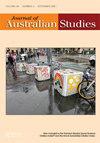亚历克西斯·赖特的《卡彭塔利亚》和珍妮特·特纳医院的《牡蛎》中的创伤、土著和修正想象
IF 0.4
3区 历史学
Q3 AREA STUDIES
引用次数: 0
摘要
本文探讨了亚历克西斯·赖特的《卡彭塔利亚》和珍妮特·特纳医院的《牡蛎》中原住民的时间和空间概念是如何通过赋予体现国家的伤害地点特权来影响个人、文化和生态创伤的表征的。空气、水、土和火这四个元素是理解每个文本如何处理土著创伤的复杂关系矩阵,以及如何应对作为澳大利亚悲惨历史一部分的种族灭绝和剥夺的持续问题的核心。这些小说中的元素能量与痛苦居住和移动的强大空间相连,提供了他们与土著和创伤接触的重要性的见解,特别是在立法机构的背景下,包括1993年的《土著权利法案》和1996年的维克决定。元素主题执行循环功能,从卡奔塔利亚的海洋意象开始,然后过渡到对国家造成的创伤,最后以宣泄的水世界末日告终。虽然奥伊斯特对基本创伤空间的考虑主要归因于土地、制图和受伤的尸体,但小说的叙事线索也达到了类似的末日结局。牡蛎灾难性的毁灭之火被水的再生能力所掩盖,水使国家恢复活力,用美丽取代恐怖。本文章由计算机程序翻译,如有差异,请以英文原文为准。
Trauma, Aboriginality and Revisionary Imaginings in Alexis Wright’s Carpentaria and Janette Turner Hospital’s Oyster
ABSTRACT This article examines how Aboriginal conceptions of time and space in Alexis Wright’s Carpentaria and Janette Turner Hospital’s Oyster affect representations of personal, cultural and ecological trauma through privileging sites of wounding that embody Country. The four elements of air, water, earth and fire are central to understanding how each text navigates the complex relational matrices of Aboriginal traumas and respond to ongoing issues of genocide and dispossession that are part of Australia’s tragic history. Elemental energies in these novels are connected to powerful spaces that pain inhabits and moves through, providing insights into the significance of their engagement with Aboriginality and trauma, particularly when situated within the context of legislature including the Native Title Act of 1993 and the Wik decision of 1996. Elemental motifs perform a cyclical function that begins with deep connectedness to oceanic imagery in Carpentaria, then transitions to trauma inflicted on Country and culminates in a cathartic watery Armageddon. While Oyster’s consideration of elemental traumatic space is primarily attributed to land, cartography and wounded bodies, the novel’s narrative threads reach a similar apocalyptic denouement. Oyster’s cataclysmic fires of destruction are eclipsed by the regenerative potencies of water that rejuvenate Country and supplant horror with beauty.
求助全文
通过发布文献求助,成功后即可免费获取论文全文。
去求助
来源期刊

Journal of Australian Studies
Multiple-
CiteScore
0.90
自引率
20.00%
发文量
56
期刊介绍:
The Journal of Australian Studies (JAS) is the journal of the International Australian Studies Association (InASA). In print since the mid-1970s, in the last few decades JAS has been involved in some of the most important discussion about the past, present and future of Australia. The Journal of Australian Studies is a fully refereed, international quarterly journal which publishes scholarly articles and reviews on Australian culture, society, politics, history and literature. The editorial practice is to promote and include multi- and interdisciplinary work.
 求助内容:
求助内容: 应助结果提醒方式:
应助结果提醒方式:


